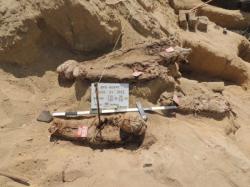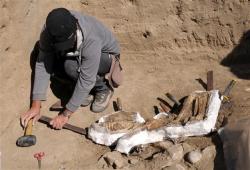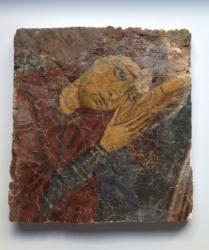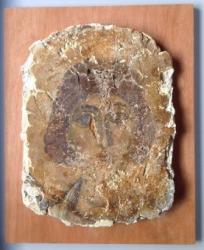INSTITUT SUPERIEUR D'ANTHROPOLOGIE
INSTITUTE OF ANTHROPOLOGY
ONLINE COURSES / COURS A DISTANCE
WINTER TERM : JANUARY 2015
REGISTER NOW
EGYPTE –  Fag el-Gamous - The Fag el-Gamous (“Way of the Water Buffalo”) cemetery has been the subject of excavation and study for over three decades, and it is believed that the cemetery served as a mass grave for poor people living when the Roman Empire controlled Egypt. Most of the mummies come from the 1st century to the 7th century A.D., and are aligned along a nearby pyramid which was built several centuries before the cemetery was established. Now, archaeologists report that the cemetery actually has over 1 million mummies. Since the cemetery was constructed for poorer people, people buried there often didn’t have a coffin or were laid without a plaque with the name or any valuable goods. However, despite their low status, archaeologists found that many people were buried with beautiful items, including linen, glass and even colorful booties. The nearby village seems to small to amount for all the people buried there, so the cemetery was likely used by people from other parts of Egypt too. There is an ancient town named Philadelphia (so named after King Ptolemy II Philadelphus) not far away, but that town has burial sites of its own. This will be one of the biggest questions archaeologists have to answer. But in terms of research, this is an endless trove – every grave tells its own stories. For example, one of the mummies was over 7 feet tall (2.1 meters), so he didn’t fit in the shaft; the graveyard workers had to bend him in half and toss him in like that. This is an extraordinary height, especially considering that ancient Egyptians generally had a very bad nutrition. The remains of a child, laid to rest more than 1,500 years ago were also found, wrapped in a tunic and wearing a necklace with two bracelets on each arm. Of course, you have one million mummies, so you can go on and on about their stories for ages. For example, archaeologists found that blond and redhead people tended to be buried in one place of the cemetery. While working on a database for all the burials, scientists found that there were clusters in the cemetery, for blonds and redheads. These clusters are interesting because they suggest “perhaps we have family areas or genetic groups [in certain areas], but we’re still trying to explore that,” Muhlestein said.
Fag el-Gamous - The Fag el-Gamous (“Way of the Water Buffalo”) cemetery has been the subject of excavation and study for over three decades, and it is believed that the cemetery served as a mass grave for poor people living when the Roman Empire controlled Egypt. Most of the mummies come from the 1st century to the 7th century A.D., and are aligned along a nearby pyramid which was built several centuries before the cemetery was established. Now, archaeologists report that the cemetery actually has over 1 million mummies. Since the cemetery was constructed for poorer people, people buried there often didn’t have a coffin or were laid without a plaque with the name or any valuable goods. However, despite their low status, archaeologists found that many people were buried with beautiful items, including linen, glass and even colorful booties. The nearby village seems to small to amount for all the people buried there, so the cemetery was likely used by people from other parts of Egypt too. There is an ancient town named Philadelphia (so named after King Ptolemy II Philadelphus) not far away, but that town has burial sites of its own. This will be one of the biggest questions archaeologists have to answer. But in terms of research, this is an endless trove – every grave tells its own stories. For example, one of the mummies was over 7 feet tall (2.1 meters), so he didn’t fit in the shaft; the graveyard workers had to bend him in half and toss him in like that. This is an extraordinary height, especially considering that ancient Egyptians generally had a very bad nutrition. The remains of a child, laid to rest more than 1,500 years ago were also found, wrapped in a tunic and wearing a necklace with two bracelets on each arm. Of course, you have one million mummies, so you can go on and on about their stories for ages. For example, archaeologists found that blond and redhead people tended to be buried in one place of the cemetery. While working on a database for all the burials, scientists found that there were clusters in the cemetery, for blonds and redheads. These clusters are interesting because they suggest “perhaps we have family areas or genetic groups [in certain areas], but we’re still trying to explore that,” Muhlestein said.
http://www.zmescience.com/science/archaeology/egyptian-cemetery-archaeology-17122014/
TURQUIE –  Misis - Excavations in the ancient city of Misis (Mopsuestia), located in the southern province of Adana, have revealed a human skeleton, which is estimated to date back to 3,000 years ago. Known as the “immortal city,” the ancient city has been excavated under the scope of a project initiated by the Yüreğir Municipality. When working on a castle from the early Islamic era, the excavation team unearthed a new finding. A detailed examination of Professor Giovanni Salmeri of Pisa University and Professor Anna Lucia D’Agata of the National Research Council at the Institute for the Study of the Ancient Mediterranean revealed that it was in fact a human skeleton. The skeleton was removed during a one-week work by the team and taken to the excavation house for analysis. Salmeri said they had found remains from the Neolithic, Chalcolithic, early Hittite, Roman and Byzantine eras in the 7,000-year-old city. “We believe this skeleton will provide us important data about the ancient city of Misis,” he said. Salmeri also said the skeleton would be analyzed by a specialists coming from Italy in two months. “The results will tell us the gender, genetic structure and age of the skeleton, as well as how this person died,” he added.
Misis - Excavations in the ancient city of Misis (Mopsuestia), located in the southern province of Adana, have revealed a human skeleton, which is estimated to date back to 3,000 years ago. Known as the “immortal city,” the ancient city has been excavated under the scope of a project initiated by the Yüreğir Municipality. When working on a castle from the early Islamic era, the excavation team unearthed a new finding. A detailed examination of Professor Giovanni Salmeri of Pisa University and Professor Anna Lucia D’Agata of the National Research Council at the Institute for the Study of the Ancient Mediterranean revealed that it was in fact a human skeleton. The skeleton was removed during a one-week work by the team and taken to the excavation house for analysis. Salmeri said they had found remains from the Neolithic, Chalcolithic, early Hittite, Roman and Byzantine eras in the 7,000-year-old city. “We believe this skeleton will provide us important data about the ancient city of Misis,” he said. Salmeri also said the skeleton would be analyzed by a specialists coming from Italy in two months. “The results will tell us the gender, genetic structure and age of the skeleton, as well as how this person died,” he added.
http://www.hurriyetdailynews.com/human-skeleton-found-in-ancient-city-of-misis.aspx?pageID=238&nID=75746&NewsCatID=375
CHYPRE – 
 Aspinthiotissa - Tasoula Hadjitofi presented four 12th century looted frescoes, two of which were taken from the Monastery of Aspinthiotissa in the occupied area of Cyprus, Kyrenia,
Aspinthiotissa - Tasoula Hadjitofi presented four 12th century looted frescoes, two of which were taken from the Monastery of Aspinthiotissa in the occupied area of Cyprus, Kyrenia,
http://www.archaeology.wiki/blog/2014/12/17/12th-century-cypriot-looted-frescoes-presented-london/